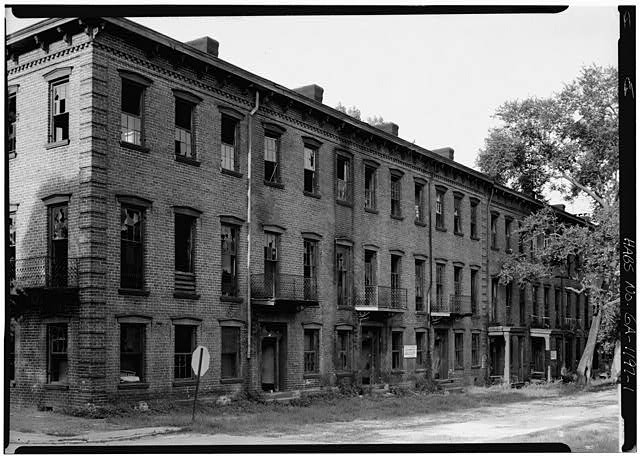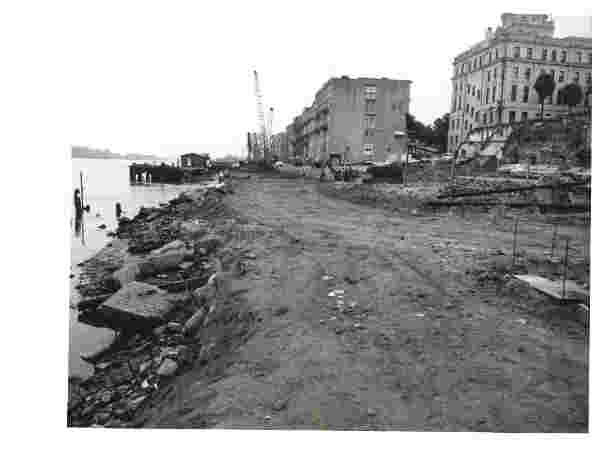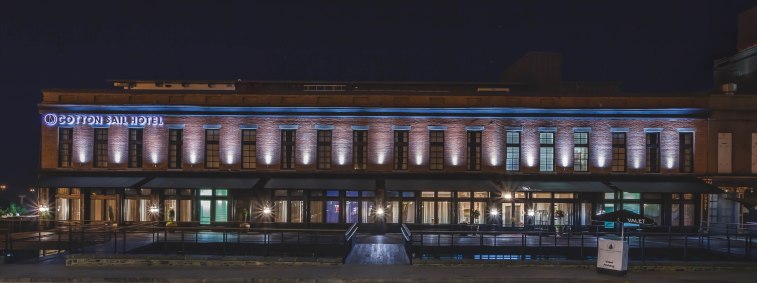Part 2 of 2 Old Savannah in Photos

The twentieth century brought Savannah heavy growth
in industry and manufacturing, mostly built upriver from the town’s core. Blue collar residents began to move into neighborhoods adjacent to the new industries. Also, the Victorian districts were built south of town, dissipating the population of the previously densely packed historic town. Still, the population experienced a 65 percent increase between 1900 and 1920– to over 83,000.
Naval stores items including pitch, turpentine, and yellow pine lumber had become important Savannah products, and the port of Savannah became the chief exporter of naval stores in the world.
But in the 1920’s came the boll weevil, which was ruinous to Savannah’s cotton market.
Also, by World War II, the naval stores industry declined due to ever-increasing usage of iron in ship manufacturing. As Savannah aided the war effort by constructing many Liberty ships, the population increasingly moved out of the old city.
Between the effects of the Great Depression and the rise of the automobile, many of the historic buildings in the city center fell into disrepair, decay, and finally, demolition. New development covered many of the old buildings with modern facades. The original squares had become inconvenient and were bisected by asphalt to allow for speeding cars and fire lanes. Old buildings were razed to sell bricks for suburban homes and to build parking lots.
The destruction, in 1954, of the old City Market, which had stood on Ellis Square since the late 1800’s, to build a municipal parking garage–became the rallying cry for historic preservation in Savannah.
When the 1821 Davenport House was threatened with demolition, seven women, led by Lucy McIntire, created the Historic Savannah Foundation which was able to halt razings and preserve many original structures. Atlanta banker Mills B. Lane prevented destruction of most of the southern portion of the historic district when Armstrong College announced it was going to build a new campus in the 1960’s. The Savannah College of Art & Design has also restored many properties, giving them new usefulness and bringing people back to live in the historic district. Reconstruction of the riverfront in the mid 1970’s was a boon to the tourist industry.
I first came to Savannah in 1982, to produce my junior final project with the University of Florida College of Architecture. Although it was inspirationally beautiful, many great architectural structures were still in decay. Savannah seemed to have somehow remained in the old south, unpainted, and under the shadows of the moss-draped oaks. There was a small but growing tourist industry, but the recession of the 70’s and the growth of the southside malls and neighborhoods had left the city in need– but still standing strong. The good effect of the slower economy and suburban focus is that an enormous percentage of historic buildings have remained intact for the future.
It was a fictional book on the 1994 New York Times Best-Seller List, Savannah’s part in the 1996 Atlanta Centennial Olympic Games, and the 1997 film of the same book, Midnight In the Garden of Good and Evil, that burst Savannah back into national focus and forever out of the contented anonymity of many previous decades. Savannah had arrived, once again, onto the world stage.
Let’s take a look at those years in photos… (most photographs courtesy of the Library of Congress Historic American Buildings Survey)
![]()
William Scarborough House, built 1819 by architect William Jay from Bath, England… now the Ships of the Sea Maritime Museum
Christ Church, built in 1840, shown in 1934
Broughton Street ca. 1930’s
Tybee Island 1930
1946

Broughton Street ca. 1970
The 1821 Isaiah Davenport House, where the Historic Savannah Foundation began.
The Davenport House Museum today
Broughton Street 1976– most of these stores moved to the suburban malls.
However, Broughton Street is currently undergoing a $75 million rejuvenation.
Suburban Motel on West Bay Street, still extant

The City Market (1870) on Ellis Square was razed in 1954 to the outrage of Savannahians.
Beautiful Ellis Square after its redevelopment a few years ago
The Georgia Historical Society in Hodgson Hall (1876) ca. 1960
Cluskey Embankment near Factor’s Walk in 1962
The old bridge from Savannah to South Carolina
Current bridge over the Savannah River and part of the fourth busiest container port in the US.
Lincoln Row before and after
Urban renewal of River Street project, Savannah 1973-1977
River Street after completion, ca. 1978
A current view of River Street– growing at both ends with more riverwalk and great hotels.
The Brice, newly opened
New hotels on West River Street, Savannah’s 3rd Bohemian Hotel on the right on the old power plant.
The Bohemian River Street with entertaining restaurants and rooftop bar.
New hotels on East River Street, one soon to be completed.
Newly opened Cotton Sail Hotel with rooftop lounge and Savannah River views














































It’s a shame to see such a grand historic city go into disrepair.
LikeLike
Beautiful. But let’s not rest, let’s keep planting more trees and resurrect the two Lost Squares, Elbert and Elbert, when the opportunity presents itself and the government buildings are up for renovation or rebuilding there. This is one of the best cities in the country to live in. A progressive city in the South with beautiful weather and city scape and most important the people here appreciate it. Just by being here a minute you practically become an architect and historian.
LikeLike
thank you Daniel this is a great montage of our city’s history. I also recommend to everyone a book called Savannah Then and Now.
LikeLike
God that big UGLY hotel at the end of River Street! Who let that be built? I left Savannah in 1977 – it was beautiful then. I worked in the Victorian looking row houses (1169 S-1). AND I remember those dirt roads where the poor blacks lived in between each lovely visitor facing street – I guess they have all been removed now.
LikeLike
I wonder if there are photos of Liberty and Elbert Squares taken before they were both reduced to the strips of land they are today thanks to “progress”. Going to Charleston and Savannah on Labor Day week and definitely will visit all 24 squares.
LikeLike
Here’s the latest statement from Mark C. McDonald, President & CEO of The Georgia Trust for Historic Preservation you might find interesting. https://gallery.mailchimp.com/ff1578446616dd2bdc8d552ce/files/5dfcb3ef-48c0-4191-b8b2-e3a1b43b796d/gatruststatement.pdf
LikeLike